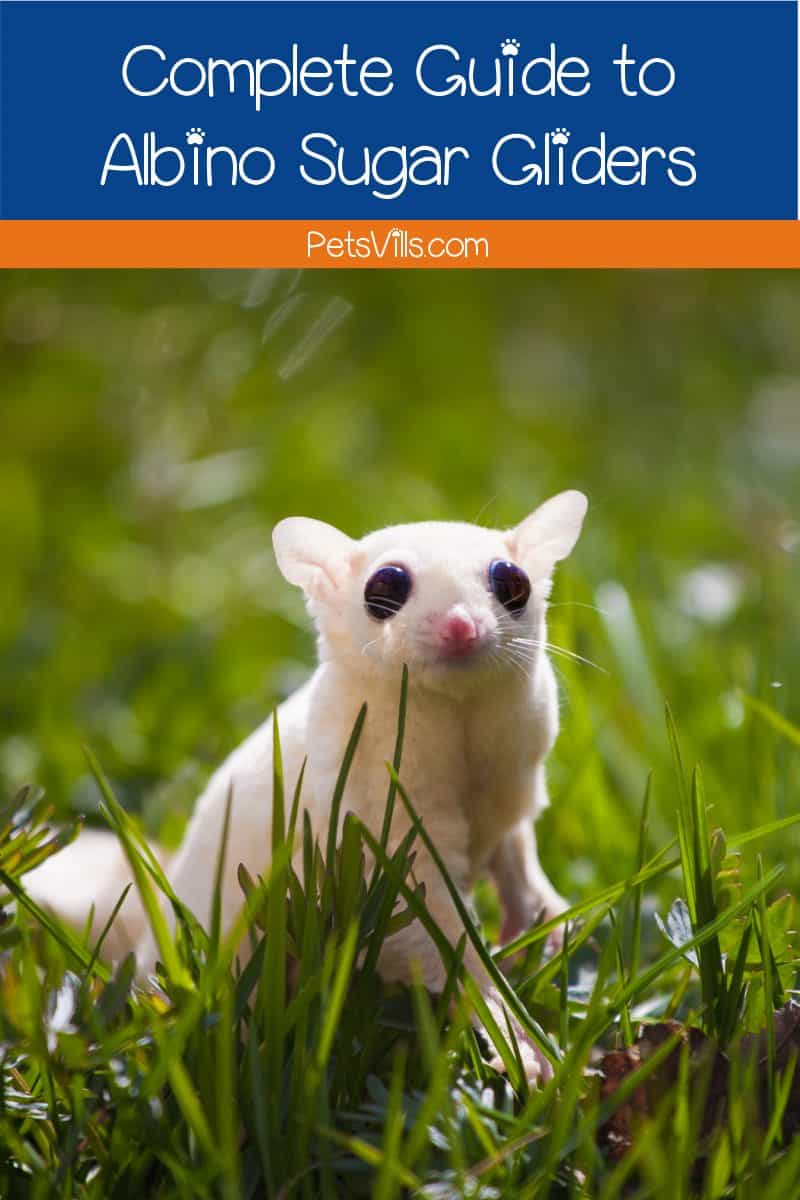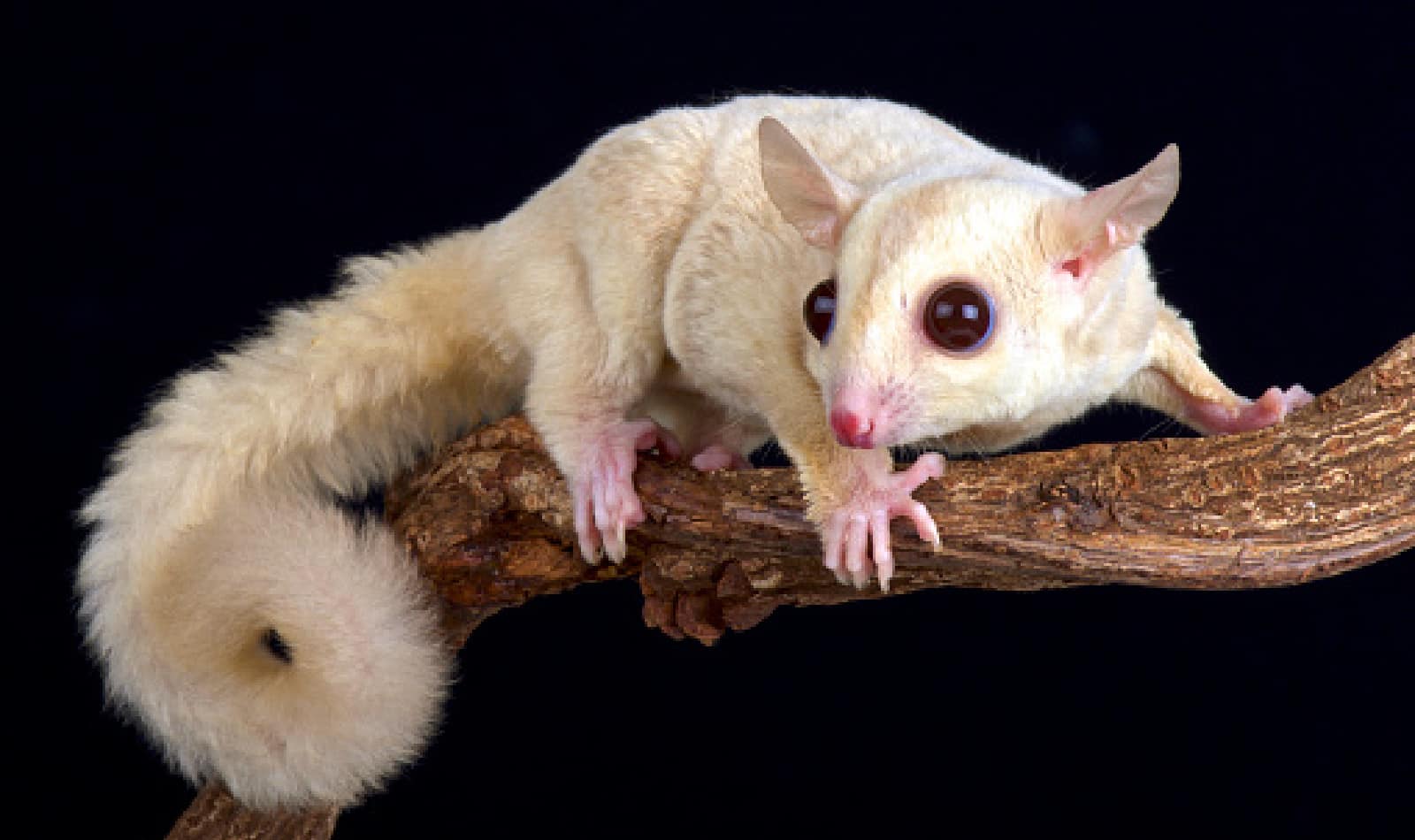Are you considering getting a pair of albino sugar gliders?
You’ve come to the right place.
We’ll go over everything you need to know about these unique pets and decide if they’re right for you!
Let’s now get this process started and determine if albino sugar glider ownership is right for you.
You may also love: Want a Sugar Glider? Here’s What You Need to Know First!

What Do Albino Sugar Gliders Look Like?
Albino sugar gliders have a very distinct appearance, which makes them a favorite among potential owners.
These animals will lack all or some pigmentation. It causes them to have completely white fur with little other markings and dark burgundy or red eyes.
If these gilders do have some pigmentation, it might show up as a yellow faint stripe or diamond.
Some other possibilities include a yellowish tip on their tails or hands.
These sugar glider coloring are considered a rare commodity among pet owners.
The albino genotype happens to recessive, and only appears when a sugar glider possesses two identical albino alleles.
ALSO CHECK: All You Need to Know About Sugar Glider Black
Lifespan
One of the first things to know about albino sugar glides is what’s behind their unique appearance.
It’s caused by a condition called albinism.
This condition is categorized as a mutation in one of the genes that provide the skin with melanin.
This mutation results in a partial or complete absence of an enzyme called tyrosinase.
It’s responsible for catalyzing melanin’s production and other pigments in hair, skin, and eyes.
In human beings, this condition can have some adverse severe vision defects. Some of them include nystagmus, photophobia, and amblyopia.
But these issues haven’t been known to extend into the lives of albino sugar gilders.
As a result, this condition shouldn’t affect an albino glider’s ability to grow old.
You can expect them to live as long as any other sugar glider, anywhere between 10-12 years.
Of course, their lifespan will depend on the type of care they’re provided.

RECOMMENDED ARTICLE: Guide to Sugar Glider Pregnancy
Cost
An albino sugar glider’s rarity can make their price tags get rather outrageous.
Heterozygous albino sugar gliders are considered the rarest and can cost as high as $5000.
If an albino sugar glider comes with pink eyes, this price lowers to around $3000 plus.
The pink eyes would result from them having a diluted gene, causing them to be seen as less rare than the first type.
Buyers who aren’t looking to spend a fortune on a newly born albino sugar glider might consider getting an older one.
Some breeders will have older gliders available for discount rates.
I’d also avoid buying any sugar glider from a pet store.
These gliders tend to have a lot more health problems than ones coming from breeders.
But please make sure your chosen breeder that’s USDA-licensed.
This action will help ensure you get the best quality albino glider possible rather than spending a fortune on one in poor health.
Adopting an albino sugar glider
It’s always better to adopt than to shop for an animal, so make that your first choice.
If you think that exotic pets aren’t found in shelters, think again!
Too often, people buy these unique creatures simply because they’re trendy.
After the Instagram likes fade away, they realize that they’ve taken on way more than they can handle.
Or they find out that sugar gliders aren’t even legal in their state.
They dump their gliders in a shelter, then move on to the next big thing.
So, call local shelters or reach out to rescue groups before you contact breeders.
Temperament
As with any sugar glider variation, albino types can make a great pet.
These animals will be playful, intelligent additions for the right home and owner.
Socialized albino sugar gliders have been known to enjoy cuddling and love curling up inside shirt pockets. I
f you give them plenty of attention, there’s no reason to believe these pets won’t form a bond with their owners.
But strangers will be a completely different story. Every type of sugar glider tends to clam up around people who aren’t around them regularly.
In these situations, the owners will often need to keep their sugar glider calm by holding them
Related: CARAMEL SUGAR GLIDERS
Related: CARAMEL SUGAR GLIDERS.
You can temper their anxiety around strangers by spending one or two hours a day handling them.
These sessions would be done better at night, considering they’re nocturnal animals.
But again, never force these animals to come in contact with people they don’t know.
It’ll often end in a disaster, such as the sugar glider vocalizing their displeasure, biting the person, or peeing on them.
None of these outcomes sound pleasant for anyone involved.
How to Care for Them
Caring for an albino sugar glider isn’t any different than any other type.
Let’s start with the proper cage (habitat is more accurate, but everyone thinks “cage,” so let’s go with that).
Albino Sugar Gliders Cage Size
Owners will want to house these animals in the largest cage possible.
It should allow them to leap, glide, and jump around the enclosure.
I’d recommend a minimum cage size for one glider to be 3-feet x 2-feet x 3-feet.
These cages should have metal constructions with bar spacing no larger than 0.5-inches apart.
After all, sugar gliders are known for being impressive escape artists.
Check out the video below for more tips on your glider’s habitat:
Exercise & Entertainment Needs
It’s essential to let these animals out of their cages daily for exercise and entertainment purposes.
But these sessions will need proper supervision because their curious natures often get them into trouble.
Owners should ensure these cages have a small bag or pouch located high up in them.
Sugar gliders love using these places for hiding and sleeping during the day
Related: Red Sugar Glider
Related: Red Sugar Glider.
Sugar glider bedding
You’ll need to line their cages with recycled paper-based or shredded paper bedding.
Please make sure to check this bedding daily and change it weekly, or these areas can get disgusting.
Other accessories and habitat care tips
Branches and shelves located inside the cage aren’t bad ideas, either.
These additions will allow your albino glider different perch options within their enclosure.
As for their fun toys or equipment, gliders have a known liking of swings and exercise wheels made for rodents.
You should keep changing their placement inside the cage to offer your gilder some mental stimulation.
Feeding your albino glider
Multiple food/water dishes should be set inside their cages and replenished daily.
It’s advisable to speak with your veterinarian about food restriction and diet requirements for sugar gliders.
Best temperature for your gluder
Lastly, try to keep their room’s temperature between 80 and 88 F at all times.
Gliders can tolerate temperatures ranging from 65 to 90 F, but the prior range is ideal for their comfort.
I hope these discussions provided a better idea of what owning albino sugar gliders is all about
Related: Black Beauty Sugar Glider
Related: Black Beauty Sugar Glider.
Do you have albino sugar gliders? Share your thoughts and experiences below!

My name is Ben Roberts, and I absolutely love animals. So, naturally, I love writing about them too! As far as my animals, I have a Pit-bull, a Beagle-lab mix, a Chihuahua, and one old cat. Each one of them provides me with a new adventure every day. And the best part is they’re all best friends. Well, except the cat when he gets a little annoyed.
FIND HIM ON: FACEBOOK and TWITTER.
Read his latest ARTICLES
Learn more about Benhere



![Cute Sugar Glider Drinking From The Bottle [Must-Watch Video]](https://petsvills.com/wp-content/uploads/2022/09/Cute-Sugar-Glider-Drinking-From-The-Bottle-Must-Watch-Video-211x150.jpg)
